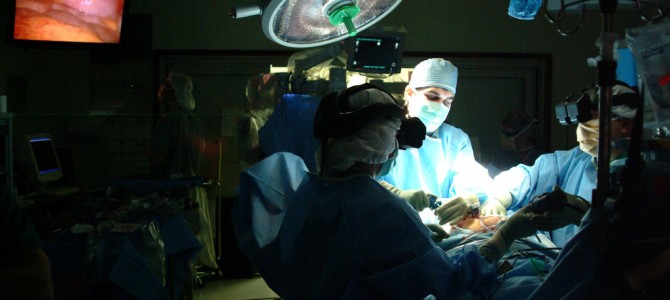A Review of ‘Doctored,’ by Sandeep Jauhar
“We live in a time of endless possibility,” proclaims Dr. John Thackery, the brilliant but opium-addled surgeon played by Clive Owen in Steven Soderburgh’s new cable TV series, The Knick. Set in New York’s Knickerbocker Hospital in 1900, the show follows Thackery and his staff as they undertake the bloody task of modernizing medicine with enthusiasm and aplomb: “More has been learned about the treatment of the human body in the last five years than was learned in the previous five hundred.”
Indeed, major breakthroughs in that era transformed medicine—and also the status of those who practiced it. Physicians in the nineteenth-century were not the esteemed professionals they would later become, and in fact were sometimes regarded with contempt and revulsion, as butchers and tradesman with very little—and often unconventional—formal education. In 1869, Harvard University President Charles Eliot said, “The ignorance and general incompetency of the average graduate of the American medical schools, at the time when he receives the degree which turns him loose upon the community, is something horrible to contemplate.”
We’ve come a long way since then. As the science of medicine matured in the twentieth century, so did the profession. In the past fifty years especially, doctors in America have enjoyed a special status—respected, admired, sometimes revered, if not wealthy then at least well-off. More importantly, as the sociologist Paul Starr noted, “they channeled the development of hospitals, health insurance, and other medical institutions into forms that did not intrude upon their autonomy.”
But the medical profession is again going through a profound transformation, except this time the change is not necessarily for the better. The rise of large corporate health insurance companies and hospital systems, together with a ceaseless deluge of government regulations, has badly eroded the independence physicians once claimed and has triggered a crisis that’s changing the way medicine is practiced in America.
Dr. Sandeep Jauhar tries to describe and personalize this crisis in his new book, Doctored, an engaging memoir that probes for the source of the “collective malaise” that grips his profession. Jauhar’s 2009 book, Intern, chronicled his harrowing residency at a busy New York hospital, an ordeal that forced him to question his basic assumptions about medicine and what it means to be a physician. His latest effort also grapples with big questions: Jauhar wants to explain why doctors are increasingly unhappy and why, in contrast to the optimism of a century ago, “The conviction that anything is possible is essentially gone.”
By framing the book around his own midlife crisis, Jauhar tries to illuminate the midlife crisis of modern American medicine, now roughly forty years old—from the advent of Medicare to the current upheavals of Obamacare. He begins his account with a new job at the Long Island Jewish Medical Center, where he’s hired as an attending cardiologist specializing in congestive heart failure, a post he hopes will afford him the opportunity “to develop close relationships with critically ill patients and provide long-term care.” Initially, Jahuar basks in the glow of working at a teaching hospital, practicing medicine in an academic setting, mostly free from the financial concerns that consume physicians in private practice, which he considers mercenary and antithetical to his high-minded notions of what the practice of medicine should be.
But the realities of the modern health care system soon obtrude on his ideals. Even at a teaching hospital, his salary is determined in part by how much revenue he generates. Jauhar soon realizes that it’s important to see as many patients as possible, and that being a hospital employee means sacrificing income for security. The divide between physicians employed by hospitals and those in private practice, he discovers, is cavernous; the former have fewer, albeit subtle, pressures on them to maximize hospital revenue, while the latter must constantly hustle for business and build their practices around tests and procedures that pay, regardless of whether patients actually need them.
When Jauhar and his wife start a family, their expenses mount and they realize his hospital salary simply isn’t enough to pay the bills (one notes, however, that they insist on living in Manhattan and sending their son to private school). To make ends meet, he takes a gig doing paid talks for a pharmaceutical company, promoting a new drug used to treat acute heart failure and reasoning that it isn’t “sleazy or unethical” because he’s prescribing the drug anyway. But Jauhar quits after a study raises questions about the drug’s safety, worried that his colleagues will perceive him as a company man.
Eventually, Jauhar is forced to work part-time at a private practice, where he experiences the mercenary side of modern medicine firsthand, mainly in the form of overutilization: if you know an insurance company will pay for a test, it’s hard not to prescribe it. As a physician, he shows a bias against insurance companies but recognizes that hospitals also exert pressure on physicians to tailor treatment around certain procedures, even as managed care organizations constantly question doctors’ judgment by demanding prior authorization for tests and prescriptions.
Together, it all adds up to a loss of professional autonomy that reverberates through the health care system. Without true independence, the doctor-patient relationship breaks down and is replaced by other forces, the chief concerns of which are not necessarily what’s best for the patient.
This dynamic lies at the heart of the crisis in American medicine that Starr predicted thirty years ago: “The prospect is not simply for the weakening of professional sovereignty, but for greater disunity, inequality, and conflict throughout the entire healthcare system.”
Surveying the contours of our current health care landscape through the keen eyes of Jauhar, it’s hard not to conclude that all of this has indeed come to pass—and that there is much more of it to come.









